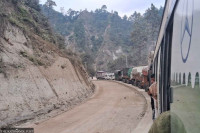Opinion
Stuck on repeat
In Nepal, the cycle of history seems unchanged; the wheel just does not seem to break
Amish Mulmi
For a Nepali columnist, there are some weeks that bring such a glut of news stories that a writer approaches their writing space with a certain glee in their mind. ‘So much to write about,’ they rub their palms and think. This past week was one such week.
Consider the many reports that made the headlines. The police cracked down on a ride-sharing app, and the prime minister stepped in to ensure the crackdown didn’t continue. A party that promised cleaner politics broke up. Dr Govinda K.C. is back on strike. The Melamchi project has stalled, once again. The purchase of a new aircraft is mired in graft accusations. Some of the country’s leading businesspeople have funds stashed away in tax havens across the globe. And we are just in the first month of 2019.
For a columnist, this is excellent fodder. After all, borrowing from the food critic Anton Ego from Ratatouille, as a columnist, ‘we thrive on negative criticism, which is fun to write and to read.’ A (reasoned) critique of policy, perceived inaction and lack of progress makes us sound formidable, and pleases us when someone on social media recommends our writing. There is also the matter of the columnist’s duty to hold up a mirror to the government, as traditional Chinese court historians did, where ‘History was a “mirror to the ruler” —and the historian held the mirror,’ as historians Cynthia Brokaw and Allison Busch have written. Then there are the anti-establishment credentials of a political columnist—although, it must be said, the tradition of mainstream columns in post-1990
Nepal has been anti-government (even if it wasn’t anti-monarchy as long as the kingship existed) no matter the party in power. Whether that says more about our governments is something that is open to interpretation.
But a year after this writer began his fortnightly column, the most noticeable aspect on a personal level has been a lingering feeling of déjà vu. The consistency and the similarities with which ‘things happen’ force a writer to think about the cyclical nature of history. Only, in Nepal’s case, it is a cycle that seems unchanged; the wheel just does not seem to break, despite the many revolutions that have called for a new one.
A similar tune
In 2000, Royal Nepal Airlines decided to lease a Boeing 767 from Austrian Lauda Air without floating any tenders. Adding up the ‘hidden costs’, the actual costs for leasing the aircraft worked out to nearly $5000 an hour, much higher than the expected cost of $3350. The names of those who benefited from the deal reached right up to the prime minister, Girija Prasad Koirala. It was Nepali corruption at its finest: the opposition asked for Koirala to quit; the minister for civil aviation resigned; the total amount of graft reached Rs. 389 million; and in 2007, a special court acquitted all those accused in the case.
I recall this incident to show the similarities between the recent accusations of corruption during the Airbus purchase. Two decades after the initial incident, it seems misappropriating funds during a purchase is a pattern. The scandal over the Airbus purchase seems to suggest even the methods and modes of corruption have remain unchanged. Reports point toward a misappropriation of Rs.2 billion in the purchase of two aircraft. An explainer by this newspaper wrote, ‘NAC officials said that the final contract price would not exceed $109 million… Based on the exchange rate [...] the cost of the planes would be Rs 22 billion. However, NAC borrowed Rs 24 billion from two financial entities.’
Anybody with a working knowledge of how Nepal operates knows that such misappropriation of funds is commonplace during any public expenditure. What’s more astounding is the regularity and the pattern in which this occurs.
And this, despite the many ways in which corruption itself has evolved across the world. The funds pocketed during purchases are small change today; corruption now bats for favourable change at the policy level. Several economists have made the argument towards what they define as ‘good corruption’, i.e. ‘corruption [that] can also grease the wheels of prosperity’, such as a bribe that allows for a bypass of red-tape and brings in much-required investment.
Of course corruption itself is a morally reprehensible choice. But consider this: what does it say about the fundamental nature of our state if even our biggest corruption scandals sound the same after two decades?
Eternal déjà vu
This is not to say Nepal hasn’t changed. If anything, there have been monumental changes in these past two decades, and progress can be measured even now. For instance, the federal wheels are in motion; the conflict between provinces and the centre over the appointment of police officials is one such instance. There is also a case to be made for the long periods of political instability and conflict that didn’t allow progress on any front. A long rope can also be extended to the new government; few remember the last time a government was elected by a majority of the popular vote.
Having said this, the concern comes from the pattern. That a man has to undertake a 16th hunger strike to get the state to reform medical education and the healthcare sector tells us of our state’s refusal to move ahead on issues it deems inimical. After all, government spendings in both education and health sectors have declined, while ‘more than two-thirds of (Rs. 60.6 bn government spending on social security and pensions in 2014) was due to retirement benefits to civil servants’. This is also evident in the tussle between states and the centre (a residue from Kathmandu’s unwillingness to address federal demands). At the same time, the provision of new laws by April that will address the grey areas of legality for ride-sharing apps tells us solutions can be found.
These instances tell us the Nepali state can be a formidable challenge to overcome for those below it, but can also buckle under the weight of pressure from those above it, just as in the days of the king. This is also why it shouldn’t come as a surprise that politics in Nepal is reduced to a game of one upmanship and a race to control the corridors of Singha Durbar. If you’re keeping the old wheels in motion by greasing them perpetually, it doesn’t matter who comes into power.
The recent Oxfam report that highlighted the glaring inequalities—‘the income of the richest 10 percent of Nepalis is more than three times that of the poorest 40 percent’ —is clinching evidence that the fruits of the many revolutions are yet to ripen. Nepal remains a cabalistic state run by bureaucrats in collusion with politicians and the private sector. With such a state of affairs, it is no wonder the Nepali columnist is eternally experiencing déjà vu.
Mulmi tweets at @amish973




 6°C Kathmandu
6°C Kathmandu












